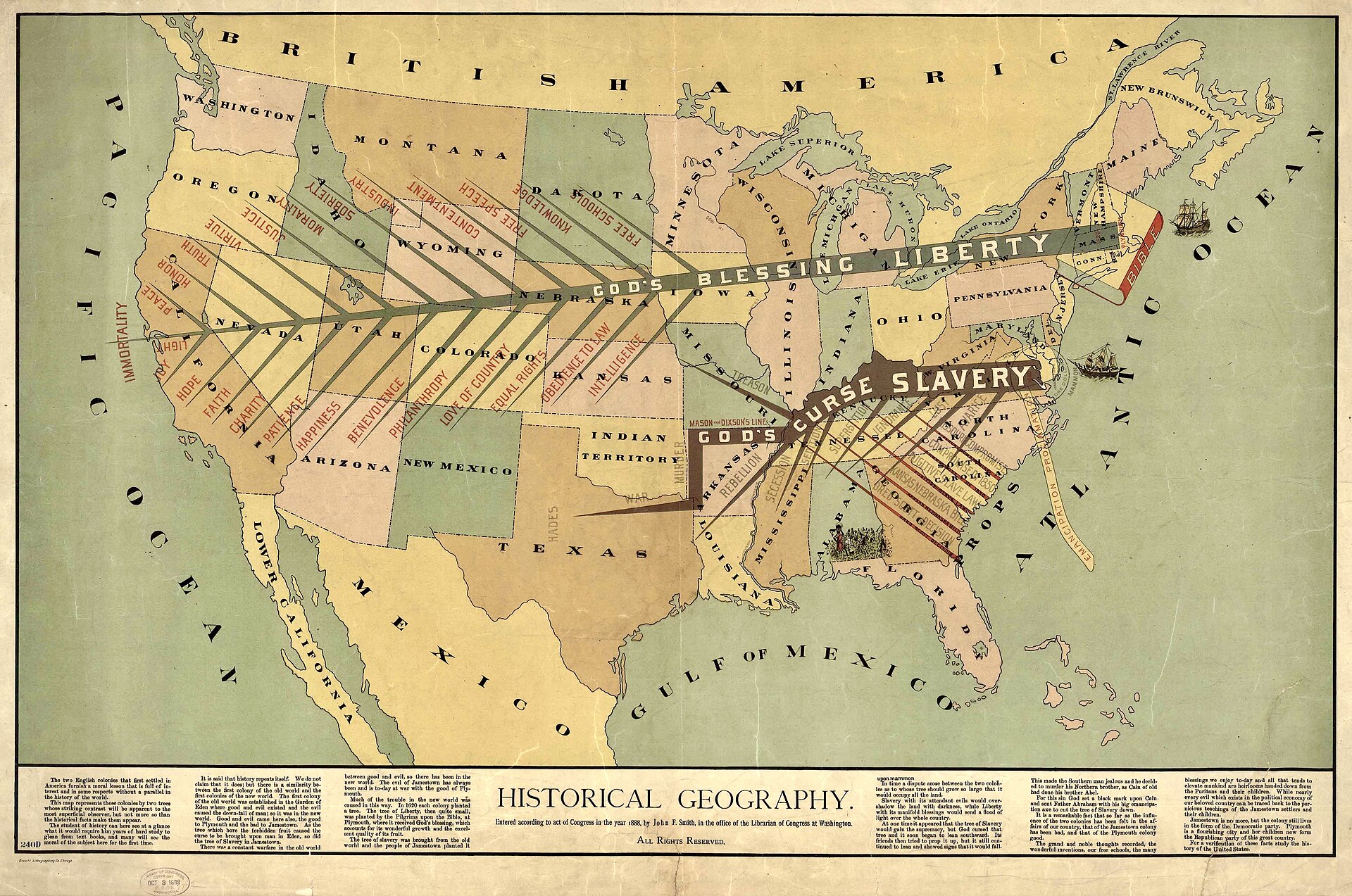
アメリカ合衆国の奴隷制小史
History of Slavery of the United States
Arguments
for and against slavery caused ongoing conflict during the first 89
years of the United States (Historical Geography, John J. Smith, 1888)
☆
主にアフリカ人とアフリカ系アメリカ人の奴隷制から成る、人間の奴隷制度は、1776年の建国から1865年まで、主に南部でアメリカ合衆国で広く行われ
ていた。奴隷制は、ヨーロッパによる南北アメリカ大陸の植民地化の全期間を通じて確立されていた。1526年からの初期の植民地時代には、後にイギリスの
植民地となる地域で奴隷制が実施されていた。その中には、アメリカ合衆国を形成した13の植民地も含まれていた。法律上、奴隷となった者は、売買や贈与が
可能な財産として扱われた。奴隷制度は1865年の廃止まで米国の約半数の州で存続し、奴隷制度に関する問題は、国民の政治、経済、社会慣習のあらゆる側
面に浸透していた。[1]
1877年の再建終了後の数十年間、隔離、小作、囚人リースなどを通じて、奴隷制度の経済的・社会的機能の多くが継続された。犯罪に対する刑罰としての非
自発的隷属は、現在でも米国では合法である。
アメリカ独立戦争(1775年~1783年)の頃には、奴隷の地位はアフリカ系の人々に関連する人種的カーストとして制度化されていた。[2]
独立戦争中および直後には、北部のほとんどの州で奴隷制度廃止法が可決され、奴隷制度廃止運動が発展した。アメリカ合衆国憲法(1789年)下における奴
隷制度の役割は、起草の過程で最も論争の的となった問題であった。憲法の「3分の2条項」は奴隷州に不均衡な政治的権力を与えたが[3]、逃亡奴隷条項
(第4条、第2節、第3項)は、奴隷が他の州に逃亡した場合、その州は所有者を名乗る人物への奴隷の返還を阻止できないと定めていた。北部の州は1805
年までに、奴隷制度をある程度廃止していた。廃止は将来の日に完了する場合もあれば、無給の年季奉公人のような中間的な状態になる場合もあった。
廃止は多くの場合、段階的なプロセスであった。主に南部の上流階級の奴隷所有者の一部は奴隷を解放し、慈善団体は奴隷を買い取って解放した。大西洋奴隷貿
易はアメリカ独立戦争中に、個々の州によって違法化され始めた。1808年には連邦議会によって輸入貿易が禁止されたが、その後も密輸が頻繁に行われたた
め、[4][5]
アメリカ合衆国税関・沿岸警備隊(沿岸警備隊)が公海上での法の執行を開始した。1820年以前には、現職議員の過半数が奴隷を所有しており、1840年
以前に生まれた議員の約30パーセント(その中には20世紀まで議員を務めた者もいた)が、生涯のある時点で奴隷を所有していたと推定されている。
綿繰り機の発明後、アメリカ深南部の綿花産業が急速に拡大したことにより、奴隷労働力に対する需要が大幅に増加し、南部諸州は奴隷社会として存続した。奴
隷州と自由州に分断されたアメリカ合衆国は、奴隷制をめぐる問題でますます二極化していった。アメリカ南部の新たな綿花農園からの労働需要に駆り立てら
れ、アメリカ南部は100万を超える奴隷を南部に送り出した。南部の奴隷人口は最終的に400万人に達した。[8][要ページ番号][9]
アメリカ合衆国の拡大に伴い、南部諸州は奴隷制を西部の新たな領土に拡大しようとし、奴隷制支持派が議会で権力を維持できるようにした。ルイジアナ買収と
メキシコ割譲によって獲得された新領土は、大きな政治危機と妥協の対象となった。[10]
南部では奴隷制は「肯定的な善」として擁護され、最大の宗教宗派は奴隷制問題をめぐって北部と南部の地域組織に分裂した。
1850年までに、新たに富を得た綿花栽培の南部は連邦からの離脱をほのめかすようになった。カンザス準州では奴隷制をめぐって流血の争いが起こった。奴
隷制の拡大阻止を公約に掲げたエイブラハム・リンカーンが1860年の選挙で勝利すると、奴隷州は連合国を結成して離脱した。その後まもなく、連合国軍が
サウスカロライナ州チャールストンにある米軍のサムター要塞を攻撃したことで南北戦争が始まった。この戦争中には、いくつかの管轄区域で奴隷制度が廃止さ
れ、連合国による没収法や奴隷解放宣言などの措置により、ほとんどの地域で事実上奴隷制度が廃止された。連合国の勝利後、1865年12月6日に米国憲法
修正第13条が批准され、「犯罪に対する刑罰としてのものを除き、奴隷制および非自発的隷属を禁止する」ことが定められた。[11]
★出典:Slavery in the United States
| Americas Further information: Atlantic slave trade; Encomienda; Mita (Inca); Institute for Trafficked, Exploited, and Missing Persons; Slavery in colonial Spanish America; Slavery in Brazil; and Slavery in the United States Slavery in Mexico can be traced back to the Aztecs.[121] Other Amerindians, such as the Inca of the Andes, the Tupinambá of Brazil, the Creek of Georgia, and the Comanche of Texas, also practiced slavery.[3] Slavery in Canada was practiced by First Nations and by European settlers.[122] Slave-owning people of what became Canada were, for example, the fishing societies, such as the Yurok, that lived along the Pacific coast from Alaska to California,[123] on what is sometimes described as the Pacific or Northern Northwest Coast. Some of the indigenous peoples of the Pacific Northwest Coast, such as the Haida and Tlingit, were traditionally known as fierce warriors and slave-traders, raiding as far as California. Slavery was hereditary, the slaves being prisoners of war and their descendants were slaves.[124] Some nations in British Columbia continued to segregate and ostracize the descendants of slaves as late as the 1970s.[125] 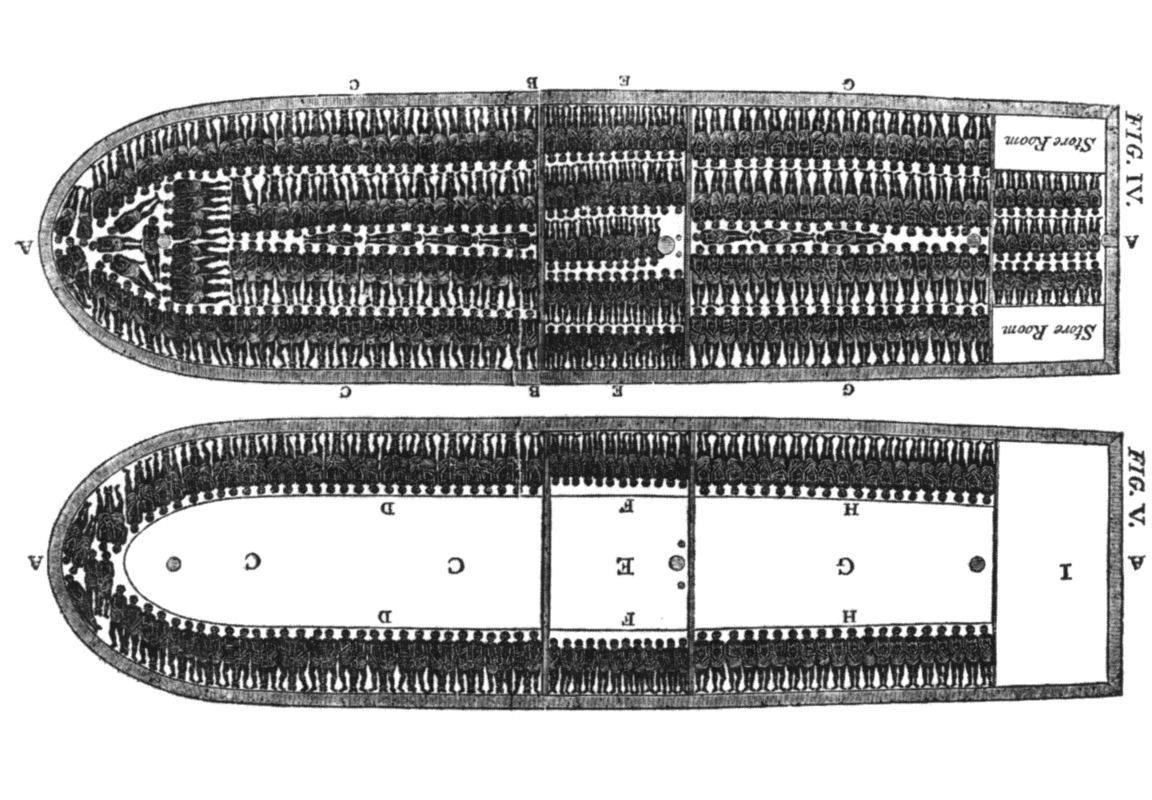 Diagrams of a slave ship and the alignment of captive slaves during the Atlantic slave trade. Slavery in America remains a contentious issue and played a major role in the history and evolution of some countries, triggering a revolution, a civil war, and numerous rebellions. The countries that controlled most of the transatlantic slave market in terms of number of slaves shipped were the UK, Portugal and France. 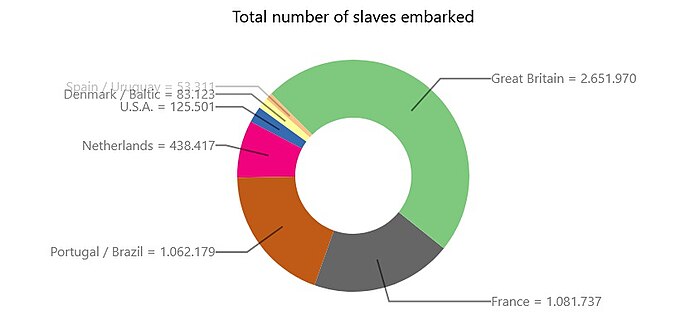 Slaves embarked to America from 1450 until 1800 by country In order to establish itself as an American empire, Spain had to fight against the relatively powerful civilizations of the New World. The Spanish conquest of the indigenous peoples in the Americas included using the Natives as forced labour. The Spanish colonies were the first Europeans to use African slaves in the New World on islands such as Cuba and Hispaniola.[126] It was argued by some contemporary writers to be intrinsically immoral.[127][128][129] Bartolomé de las Casas, a 16th-century Dominican friar and Spanish historian, participated in campaigns in Cuba (at Bayamo and Camagüey) and was present at the massacre of Hatuey; his observation of that massacre led him to fight for a social movement away from the use of natives as slaves. Also, the alarming decline in the native population had spurred the first royal laws protecting the native population. The first African slaves arrived in Hispaniola in 1501.[130] This era saw a growth in race-based slavery[131] England played a prominent role in the Atlantic slave trade. The "slave triangle" was pioneered by Francis Drake and his associates, though English slave-trading would not take off until the mid-17th century. Many whites who arrived in North America during the 17th and 18th centuries came under contract as indentured servants.[132] The transformation from indentured servitude to slavery was a gradual process in Virginia. The earliest legal documentation of such a shift was in 1640 where a black man, John Punch, was sentenced to lifetime slavery, forcing him to serve his master, Hugh Gwyn, for the remainder of his life, for attempting to run away. This case was significant because it established the disparity between his sentence as a black man and that of the two white indentured servants who escaped with him (one described as Dutch and one as a Scotchman). It is the first documented case of a black man sentenced to lifetime servitude and is considered one of the first legal cases to make a racial distinction between black and white indentured servants.[133][134] After 1640, planters started to ignore the expiration of indentured contracts and keep their servants as slaves for life. This was demonstrated by the 1655 case Johnson v. Parker, where the court ruled that a black man, Anthony Johnson of Virginia, was granted ownership of another black man, John Casor, as the result of a civil case.[135] This was the first instance of a judicial determination in the Thirteen Colonies holding that a person who had committed no crime could be held in servitude for life.[136][137] |
アメリカ大陸 さらに詳しい情報 大西洋奴隷貿易、エンコミエンダ、ミタ(インカ)、人身売買・搾取・行方不明者研究所、植民地時代のスペイン領アメリカの奴隷制、ブラジルの奴隷制、アメリカの奴隷制 メキシコの奴隷制度はアステカまで遡ることができる[121]。アンデスのインカ、ブラジルのトゥピナンバ、ジョージアのクリーク、テキサスのコマンチなど、他のアメリカ先住民も奴隷制度を実施していた[3]。 カナダにおける奴隷制度は、先住民やヨーロッパ人入植者によって行われていた[122]。 カナダとなった地域の奴隷を所有していた人々は、例えば、アラスカからカリフォルニアに至る太平洋沿岸、太平洋沿岸または北西北部沿岸と表現されることも ある地域[123]に住んでいたユロック族のような漁業社会であった。ハイダ族やトリンギット族など、太平洋岸北西部の先住民の一部は、伝統的に獰猛な戦 士として知られ、カリフォルニアまで略奪する奴隷商人であった。奴隷制度は世襲制であり、奴隷は捕虜であり、その子孫は奴隷であった[124]。ブリ ティッシュコロンビア州のいくつかの国家は、1970年代後半になっても奴隷の子孫を隔離し、追放し続けていた[125]。  大西洋奴隷貿易における奴隷船と捕虜奴隷の配置図。 アメリカにおける奴隷制度は今でも論争の的となっており、革命、内戦、数々の反乱を引き起こし、いくつかの国の歴史と進化に大きな役割を果たした。 奴隷の出荷数で大西洋横断奴隷市場の大半を支配していたのは、イギリス、ポルトガル、フランスであった。  1450年から1800年までにアメリカに渡った奴隷の国別内訳 アメリカ帝国としての地位を確立するために、スペインは新世界の比較的強力な文明と戦わなければならなかった。スペインによるアメリカ大陸の先住民征服に は、先住民を強制労働力として使うことも含まれていた。スペインの植民地は、キューバやイスパニョーラのような島々において、新世界でアフリカ人奴隷を使 用した最初のヨーロッパ人であった[126]。 [127][128][129]16世紀のドミニコ会修道士でありスペインの歴史家であったバルトロメ・デ・ラス・カサスは、キューバでのキャンペーン (バヤモとカマグエイ)に参加し、ハトゥエイの虐殺に立ち会った。また、先住民の減少が憂慮され、先住民を保護する最初の王法が制定された。最初のアフリ カ人奴隷は1501年にイスパニョーラに到着した[130]。この時代、人種に基づく奴隷制度が発展した[131]。イギリスは大西洋奴隷貿易において重 要な役割を果たした。奴隷の三角形」はフランシス・ドレイクとその仲間によって開拓されたが、イギリスの奴隷貿易が本格化するのは17世紀半ばのことであ る。 17世紀から18世紀にかけて北米に到着した白人の多くは、年季奉公人として契約を結んでいた[132]。年季奉公から奴隷制への転換は、ヴァージニアで は徐々に進んだ。このような変化を示す最古の法的文書は、1640年に黒人のジョン・パンチが、逃亡を図ったという理由で、主人であるヒュー・グウィンに 一生仕えなければならないという終身奴隷の判決を言い渡された事件である。この事件は、黒人としての彼の量刑と、彼と一緒に逃亡した2人の白人年季奉公人 (1人はオランダ人、1人はスコットランド人と記述)の量刑との間に格差があることを立証した点で重要であった。これは、終身隷属を言い渡された黒人の最 初の文書化された事例であり、黒人と白人の年季奉公人を人種的に区別した最初の法的事例のひとつと考えられている[133][134]。 1640年以降、プランターは年季奉公契約の満了を無視し、使用人を終身奴隷として飼うようになった。これは1655年のジョンソン対パーカー事件で示さ れたものであり、裁判所は民事裁判の結果、ヴァージニアの黒人アンソニー・ジョンソンに別の黒人ジョン・カソールの所有権を認める判決を下した [135]。これは13植民地において、何の罪も犯していない人間を終身隷属させることができるとする司法判断の最初の事例であった[136] [137]。 |
United States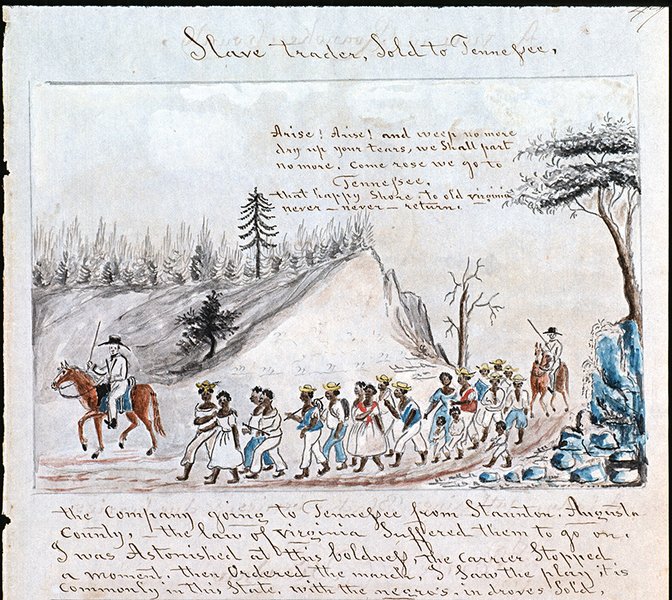 A coffle of slaves being driven on foot from Staunton, Virginia to Tennessee in 1850. Slavery in the United States was the legal institution of human chattel enslavement, primarily of Africans and African Americans, that existed in the United States of America in the 18th and 19th centuries, after it gained independence from the British and before the end of the American Civil War. Slavery had been practiced in British America from early colonial days and was legal in all Thirteen Colonies, at the time of the Declaration of Independence in 1776. By the time of the American Revolution, the status of slave had been institutionalized as a racial caste associated with African ancestry.[153] The United States became polarized over the issue of slavery, represented by the slave and free states divided by the Mason–Dixon line, which separated free Pennsylvania from slave Maryland and Delaware. Congress, during the Jefferson administration, prohibited the importation of slaves, effective 1808, although smuggling (illegal importing) was not unusual.[154] Domestic slave trading, however, continued at a rapid pace, driven by labour demands from the development of cotton plantations in the Deep South. Those states attempted to extend slavery into the new western territories to keep their share of political power in the nation. Such laws proposed to Congress to continue the spread of slavery into newly ratified states include the Kansas-Nebraska Act. The treatment of slaves in the United States varied widely depending on conditions, times, and places. The power relationships of slavery corrupted many whites who had authority over slaves, with children showing their own cruelty. Masters and overseers resorted to physical punishments to impose their wills. Slaves were punished by whipping, shackling, hanging, beating, burning, mutilation, branding and imprisonment. Punishment was most often meted out in response to disobedience or perceived infractions, but sometimes abuse was carried out to re-assert the dominance of the master or overseer of the slave.[155] Treatment was usually harsher on large plantations, which were often managed by overseers and owned by absentee slaveholders. William Wells Brown, who escaped to freedom, reported that on one plantation, slave men were required to pick 80 pounds (36 kg) of cotton per day, while women were required to pick 70 pounds (32 kg) per day; if any slave failed in their quota, they were subject to whip lashes for each pound they were short. The whipping post stood next to the cotton scales.[156] A New York man who attended a slave auction in the mid-19th century reported that at least three-quarters of the male slaves he saw at sale had scars on their backs from whipping.[157] By contrast, small slave-owning families had closer relationships between the owners and slaves; this sometimes resulted in a more humane environment but was not a given.[155] More than one million slaves were sold from the Upper South, which had a surplus of labour, and taken to the Deep South in a forced migration, splitting up many families. New communities of African American culture were developed in the Deep South, and the total slave population in the South eventually reached 4 million before liberation.[158][159] In the 19th century, proponents of slavery often defended the institution as a "necessary evil". White people of that time feared that emancipation of black slaves would have more harmful social and economic consequences than the continuation of slavery. The French writer and traveler Alexis de Tocqueville, in Democracy in America (1835), expressed opposition to slavery while observing its effects on American society. He felt that a multiracial society without slavery was untenable, as he believed that prejudice against black people increased as they were granted more rights. Others, like James Henry Hammond argued that slavery was a "positive good" stating: "Such a class you must have, or you would not have that other class which leads progress, civilization, and refinement." The Southern state governments wanted to keep a balance between the number of slave and free states to maintain a political balance of power in Congress. The new territories acquired from Britain, France, and Mexico were the subject of major political compromises. By 1850, the newly rich cotton-growing South was threatening to secede from the Union, and tensions continued to rise. Many white Southern Christians, including church ministers, attempted to justify their support for slavery as modified by Christian paternalism.[160] The largest denominations, the Baptist, Methodist, and Presbyterian churches, split over the slavery issue into regional organizations of the North and South. 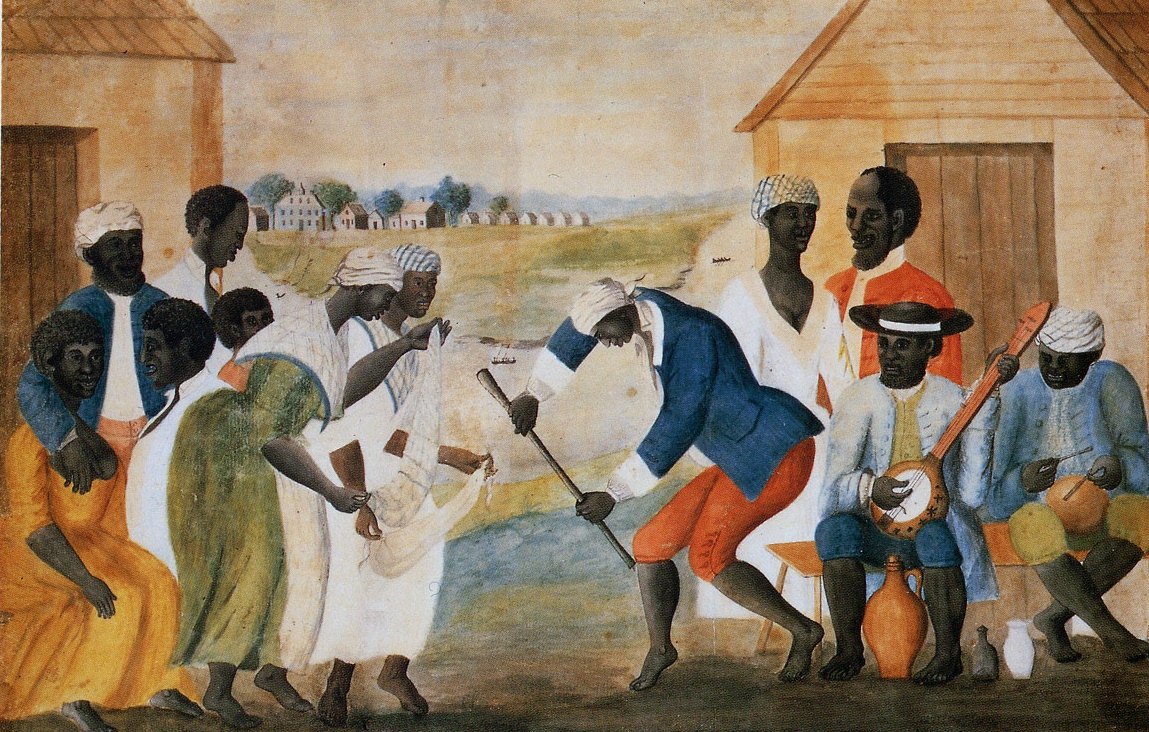 Slaves on a Virginia plantation (The Old Plantation, c. 1790). When Abraham Lincoln won the 1860 election on a platform of halting the expansion of slavery, according to the 1860 U.S. census, roughly 400,000 individuals, representing 8% of all U.S. families, owned nearly 4,000,000 slaves.[161] One-third of Southern families owned slaves.[162] The South was heavily invested in slavery. As such, upon Lincoln's election, seven states broke away to form the Confederate States of America. The first six states to secede held the greatest number of slaves in the South. Shortly after, over the issue of slavery, the United States erupted into an all-out Civil War, with slavery legally ceasing as an institution following the war in December 1865. In 1865, the United States ratified the 13th Amendment to the United States Constitution, which banned slavery and involuntary servitude "except as punishment for a crime whereof the party shall have been duly convicted," providing a legal basis for forced labor to continue in the country. This led to the system of convict leasing, which affected primarily African Americans. The Prison Policy Initiative, an American criminal justice think tank, cites the 2020 US prison population as 2.3 million, and nearly all able-bodied inmates work in some fashion. In Texas, Georgia, Alabama and Arkansas, prisoners are not paid at all for their work. In other states, prisoners are paid between $0.12 and $1.15 per hour. Federal Prison Industries paid inmates an average of $0.90 per hour in 2017. Inmates who refuse to work may be indefinitely remanded into solitary confinement or have family visitation revoked. From 2010 to 2015 and again in 2016 and in 2018, some prisoners in the US refused to work, protesting for better pay, better conditions, and for the end of forced labor. Strike leaders were punished with indefinite solitary confinement. Forced prison labor occurs in both government-run prisons and private prisons. CoreCivic and GEO Group constitute half the market share of private prisons, and they made a combined revenue of $3.5 billion in 2015. The value of all labor by inmates in the United States is estimated to be in the billions. In California, 2,500 incarcerated workers fought wildfires for only $1 per hour through the CDCR's Conservation Camp Program, which saves the state as much as $100 million a year.[163] |
アメリカ合衆国 1850年、ヴァージニア州スタントンからテネシー州へ徒歩で移動する奴隷の一団。 アメリカ合衆国の奴隷制度とは、18世紀から19世紀にかけて、アメリカ合衆国がイギリスから独立した後、アメリカ南北戦争が終結するまでに存在した、主 にアフリカ人とアフリカ系アメリカ人を対象とした、人間の動産を奴隷とする法的制度である。奴隷制度はイギリス領アメリカでは植民地時代初期から行われて おり、1776年の独立宣言の時点では、13植民地すべてで合法であった。アメリカ独立の頃には、奴隷の地位はアフリカ人の先祖に関連する人種カーストと して制度化されていた[153]。アメリカは奴隷制の問題をめぐって二極化し、メイソン・ディクソン線によって自由州のペンシルベニア州と奴隷州のメリー ランド州とデラウェア州が分断された。 ジェファーソン政権下の1808年、議会は奴隷の輸入を禁止したが、密輸(不法輸入)は珍しいことではなかった[154]。これらの州は、国家の政治的権 力を維持するために、奴隷制を新しい西部領土に拡大しようとした。新たに批准した州への奴隷制の拡大を継続するために議会に提案された法律には、カンザ ス・ネブラスカ法などがある。 アメリカにおける奴隷の扱いは、状況、時代、場所によって大きく異なる。奴隷制の力関係は、奴隷に対する権威を持つ多くの白人を堕落させ、子供たちは自ら 残酷さを示すようになった。主人や監督は、自分たちの意志を押し付けるために肉体的な罰に頼った。奴隷は鞭打ち、手かせ足かせ、首吊り、殴打、火あぶり、 切断、焼き印、投獄によって罰せられた。処罰は、不服従や自覚された違反に対して行われることがほとんどであったが、奴隷の主人や監督の支配を再確認する ために虐待が行われることもあった[155]。 自由を求めて逃亡したウィリアム・ウェルズ・ブラウンの報告によると、ある農園では、奴隷の男性は1日80ポンド(36キロ)、女性は1日70ポンド (32キロ)の綿花を摘むことが義務付けられていた。19世紀半ばに奴隷の競売に参加したニューヨークのある男性は、売りに出された男性奴隷の少なくとも 4分の3は背中に鞭打ちの傷跡があったと報告している[157]。対照的に、小規模の奴隷所有者一家は所有者と奴隷の関係を緊密にしていた。 100万人以上の奴隷が、労働力が余っていた上部南部から売られ、強制移住で深南部に連れて行かれ、多くの家族が分裂した。アフリカ系アメリカ人文化の新 たなコミュニティが深南部で発展し、南部の奴隷総人口は解放前に最終的に400万人に達した[158][159]。 19世紀には、奴隷制度の支持者はしばしば奴隷制度を「必要悪」として擁護した。当時の白人は、黒人奴隷の解放が奴隷制の継続よりも有害な社会的・経済的 結果をもたらすことを恐れていた。フランスの作家であり旅行家でもあったアレクシス・ド・トクヴィルは、『アメリカの民主主義』(1835年)の中で、奴 隷制度がアメリカ社会に及ぼす影響を観察しながら、奴隷制度への反対を表明した。彼は、奴隷制のない多民族社会は成り立たないと考え、黒人に対する偏見 は、黒人により多くの権利が与えられるにつれて増大すると考えたからである。また、ジェームズ・ヘンリー・ハモンドのように、奴隷制度は「積極的な善」で あると主張する者もいた: 「このような階級がなければ、進歩、文明、洗練を導く他の階級は生まれないだろう」。 南部の州政府は、議会における政治的権力の均衡を保つため、奴隷州と自由州の数のバランスを保ちたいと考えていた。イギリス、フランス、メキシコから獲得 した新しい領土は、政治的に大きな妥協の対象となった。1850年までに、新たに豊かになった綿花栽培の南部は連邦から離脱する恐れがあり、緊張は高まり 続けた。教会の牧師を含む多くの南部の白人キリスト教徒は、キリスト教的パターナリズムによって修正されたものとして、奴隷制支持を正当化しようとした [160]。最大の教派であるバプテスト教会、メソジスト教会、長老派教会は、奴隷制問題をめぐって南北の地域組織に分裂した。  ヴァージニア農園の奴隷(The Old Plantation、1790年頃)。 エイブラハム・リンカーンが奴隷制の拡大阻止を掲げて1860年の選挙に勝利したとき、1860年のアメリカの国勢調査によると、アメリカ全世帯の8%に 相当するおよそ40万人が400万人近くの奴隷を所有していた[161]。 南部世帯の3分の1が奴隷を所有していた[162]。南部は奴隷制に大きく投資していた。そのため、リンカーンの当選と同時に7つの州が離脱し、南部連合 を結成した。最初に脱退した6つの州は、南部で最も多くの奴隷を抱えていた。その直後、奴隷制の問題をめぐってアメリカは全面的な南北戦争に突入し、 1865年12月の戦争終結後、奴隷制度は法的に廃止された。 1865年、米国は合衆国憲法修正第13条を批准し、「当事者が正当に有罪判決を受けた犯罪に対する刑罰としての場合を除き」、奴隷制と非自発的隷属を禁 止し、強制労働が国内で継続される法的根拠を与えた。これが、主にアフリカ系アメリカ人に影響を与えた囚人リース制度につながった。アメリカの刑事司法シ ンクタンク、プリズン・ポリシー・イニシアティブは、2020年のアメリカの刑務所人口を230万人としており、健常な受刑者のほぼ全員が何らかの形で働 いている。テキサス州、ジョージア州、アラバマ州、アーカンソー州では、受刑者は労働に対してまったく賃金を支払われていない。その他の州では、受刑者の 時給は0.12ドルから1.15ドルである。連邦刑務所産業は2017年、受刑者に平均時給0.90ドルを支払った。労働を拒否した受刑者は、無期限で独 房に収容されたり、家族との面会が剥奪されたりする。2010年から2015年まで、そして2016年と2018年にも、アメリカでは一部の受刑者が労働 を拒否し、賃金の改善や条件の改善、強制労働の廃止を求めて抗議した。ストライキの指導者は、無期限の独房監禁で処罰された。強制労働は、政府が運営する 刑務所と民間の刑務所の両方で発生している。コア・シビックとゲオ・グループは民間刑務所の市場シェアの半分を占め、2015年には合わせて35億ドルの 収益を上げている。米国における受刑者の全労働価値は数十億ドルに上ると推定される。カリフォルニア州では、2,500人の収監労働者がCDCRのコンサ ベーション・キャンプ・プログラムを通じて1時間あたりわずか1ドルで山火事に立ち向かい、州は年間1億ドルもの節約をしている[163]。 |
| https://en.wikipedia.org/wiki/Slavery |
|
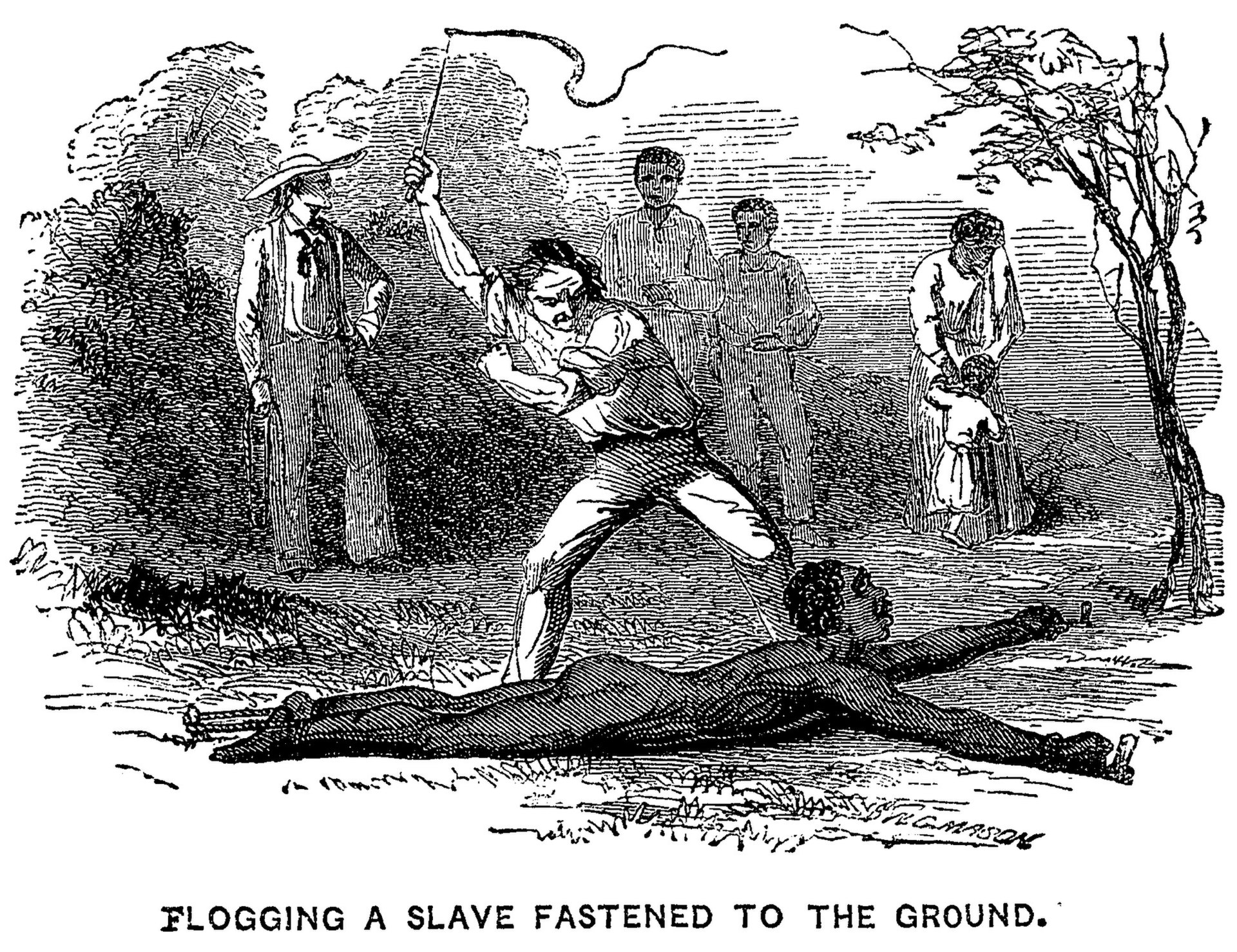 Flogging a slave fastened to the ground, illustration in an 1853 anti-slavery pamphlet |
 1853年の反奴隷制パンフレットの挿絵、地面に縛り付けられた奴隷を鞭打つ |
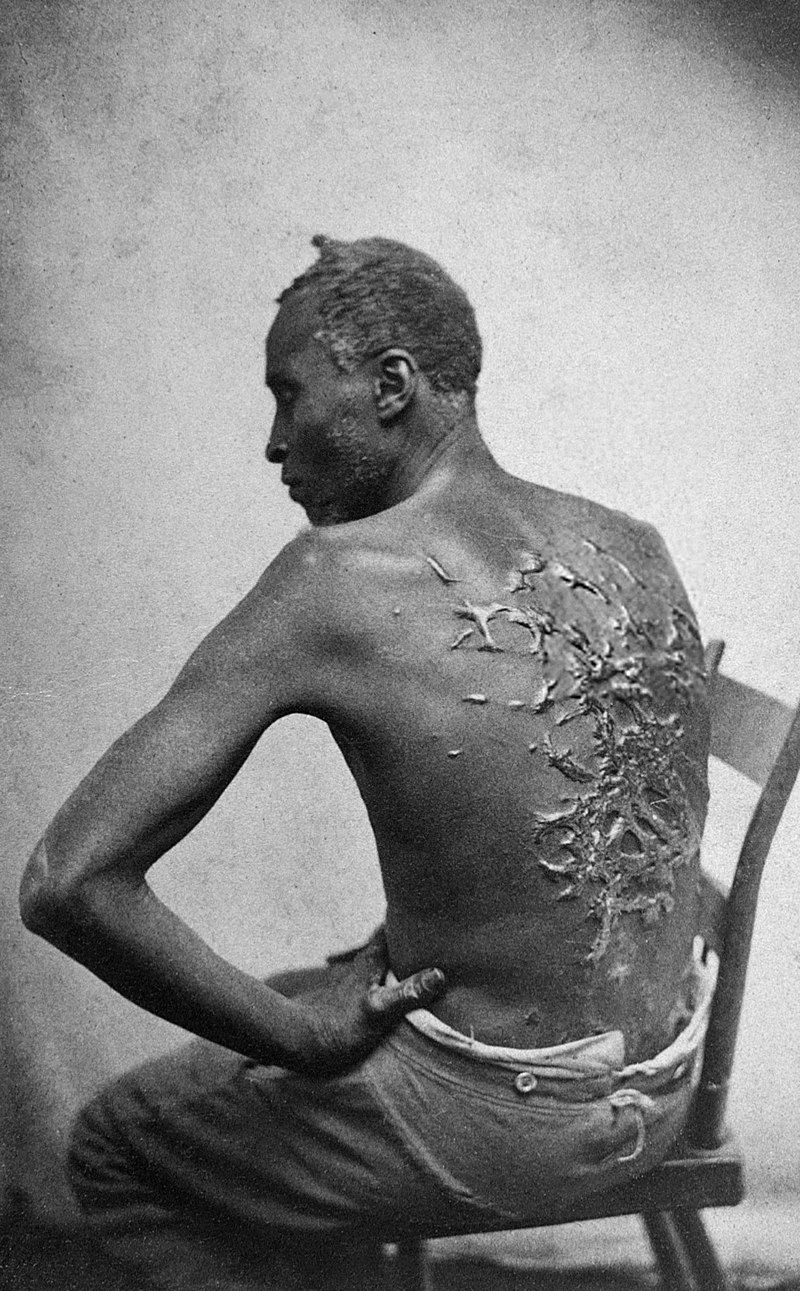 Gordon, a slave from Louisiana, in 1863. The scars are the result of a whipping by his overseer. |
 1863年、ルイジアナ州出身の奴隷ゴードン。この傷跡は、監督官による鞭打ちの跡である。 |
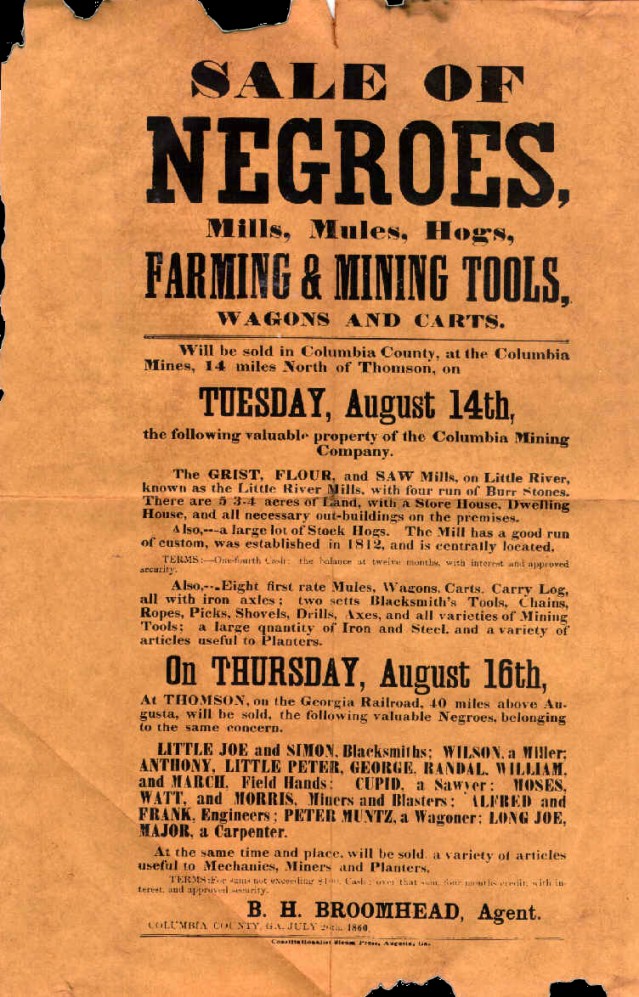 A poster for a slave auction in Georgia, U.S., 1860 |
 1860年、アメリカ、ジョージア州の奴隷オークションのポスター。 |
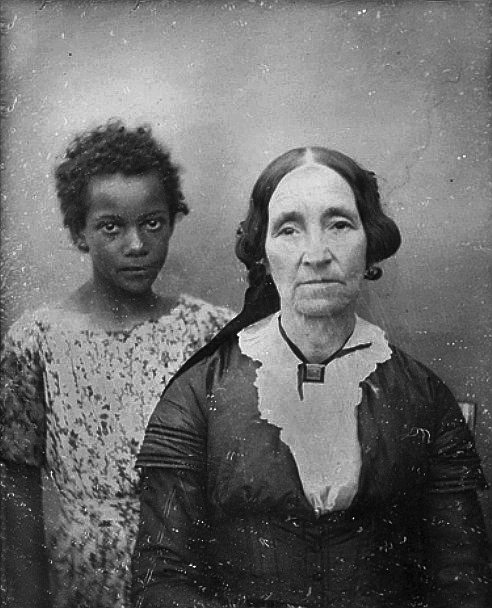 Portrait of an older woman in New Orleans with her enslaved servant girl in the mid-19th century |
 19世紀半ば、ニューオーリンズで奴隷にされた使用人の少女を連れた年配の女性の肖像画 |
| より詳しくは、Slavery in the United States | より詳しくは、Slavery in the United States |
| The
legal institution of human chattel slavery, comprising the enslavement
primarily of Africans and African Americans, was prevalent in the
United States of America from its founding in 1776 until 1865,
predominantly in the South. Slavery was established throughout European
colonization in the Americas. From 1526, during the early colonial
period, it was practiced in what became Britain's colonies, including
the Thirteen Colonies that formed the United States. Under the law, an
enslaved person was treated as property that could be bought, sold, or
given away. Slavery lasted in about half of U.S. states until abolition
in 1865, and issues concerning slavery seeped into every aspect of
national politics, economics, and social custom.[1] In the decades
after the end of Reconstruction in 1877, many of slavery's economic and
social functions were continued through segregation, sharecropping, and
convict leasing. Involuntary servitude as a punishment for crime is
still legal in the United States. By the time of the American Revolutionary War (1775–1783), the status of enslaved people had been institutionalized as a racial caste associated with African ancestry.[2] During and immediately following the Revolution, abolitionist laws were passed in most Northern states and a movement developed to abolish slavery. The role of slavery under the United States Constitution (1789) was the most contentious issue during its drafting. The Three-Fifths Clause of the Constitution gave slave states disproportionate political power,[3] while the Fugitive Slave Clause (Article IV, Section 2, Clause 3) provided that, if a slave escaped to another state, the other state could not prevent the return of the slave to the person claiming to be his or her owner. All Northern states had abolished slavery to some degree by 1805, sometimes with completion at a future date, sometimes with an intermediary status of unpaid indentured servant. Abolition was in many cases a gradual process. Some slaveowners, primarily in the Upper South, freed their slaves, and charitable groups bought and freed others. The Atlantic slave trade began to be outlawed by individual states during the American Revolution. The import trade was banned by Congress in 1808, although smuggling was common thereafter,[4][5] at which point the U.S. Revenue Cutter Service (Coast Guard) began enforcing the law on the high seas.[6] It has been estimated that before 1820 a majority of serving congressmen owned slaves, and that about 30 percent of congressmen who were born before 1840 (some of whom served into the 20th century) owned slaves at some time in their lives.[7] The rapid expansion of the cotton industry in the Deep South after the invention of the cotton gin greatly increased demand for slave labor, and the Southern states continued as slave societies. The U.S., divided into slave and free states, became ever more polarized over the issue of slavery. Driven by labor demands from new cotton plantations in the Deep South, the Upper South sold more than a million slaves who were taken to the Deep South. The total slave population in the South eventually reached four million.[8][page needed][9] As the U.S. expanded, the Southern states attempted to extend slavery into the new Western territories to allow proslavery forces to maintain power in Congress. The new territories acquired by the Louisiana Purchase and the Mexican Cession were the subject of major political crises and compromises.[10] Slavery was defended in the South as a "positive good", and the largest religious denominations split over the slavery issue into regional organizations of the North and South. By 1850, the newly rich, cotton-growing South threatened to secede from the Union. Bloody fighting broke out over slavery in the Kansas Territory. When Abraham Lincoln won the 1860 election on a platform of halting the expansion of slavery, slave states seceded to form the Confederacy. Shortly afterward, the Civil War began when Confederate forces attacked the U.S. Army's Fort Sumter in Charleston, South Carolina. During the war some jurisdictions abolished slavery and, due to Union measures such as the Confiscation Acts and the Emancipation Proclamation, the war effectively ended slavery in most places. After the Union victory, the Thirteenth Amendment to the United States Constitution was ratified on December 6, 1865, prohibiting "slavery [and] involuntary servitude, except as a punishment for crime."[11] |
主
にアフリカ人とアフリカ系アメリカ人の奴隷制から成る、人間の奴隷制度は、1776年の建国から1865年まで、主に南部でアメリカ合衆国で広く行われて
いた。奴隷制は、ヨーロッパによる南北アメリカ大陸の植民地化の全期間を通じて確立されていた。1526年からの初期の植民地時代には、後にイギリスの植
民地となる地域で奴隷制が実施されていた。その中には、アメリカ合衆国を形成した13の植民地も含まれていた。法律上、奴隷となった者は、売買や贈与が可
能な財産として扱われた。奴隷制度は1865年の廃止まで米国の約半数の州で存続し、奴隷制度に関する問題は、国民の政治、経済、社会慣習のあらゆる側面
に浸透していた。[1]
1877年の再建終了後の数十年間、隔離、小作、囚人リースなどを通じて、奴隷制度の経済的・社会的機能の多くが継続された。犯罪に対する刑罰としての非
自発的隷属は、現在でも米国では合法である。 アメリカ独立戦争(1775年~1783年)の頃には、奴隷の地位はアフリカ系の人々に関連する人種的カーストとして制度化されていた。[2] 独立戦争中および直後には、北部のほとんどの州で奴隷制度廃止法が可決され、奴隷制度廃止運動が発展した。アメリカ合衆国憲法(1789年)下における奴 隷制度の役割は、起草の過程で最も論争の的となった問題であった。憲法の「3分の2条項」は奴隷州に不均衡な政治的権力を与えたが[3]、逃亡奴隷条項 (第4条、第2節、第3項)は、奴隷が他の州に逃亡した場合、その州は所有者を名乗る人物への奴隷の返還を阻止できないと定めていた。北部の州は1805 年までに、奴隷制度をある程度廃止していた。廃止は将来の日に完了する場合もあれば、無給の年季奉公人のような中間的な状態になる場合もあった。 廃止は多くの場合、段階的なプロセスであった。主に南部の上流階級の奴隷所有者の一部は奴隷を解放し、慈善団体は奴隷を買い取って解放した。大西洋奴隷貿 易はアメリカ独立戦争中に、個々の州によって違法化され始めた。1808年には連邦議会によって輸入貿易が禁止されたが、その後も密輸が頻繁に行われたた め、[4][5] アメリカ合衆国税関・沿岸警備隊(沿岸警備隊)が公海上での法の執行を開始した。1820年以前には、現職議員の過半数が奴隷を所有しており、1840年 以前に生まれた議員の約30パーセント(その中には20世紀まで議員を務めた者もいた)が、生涯のある時点で奴隷を所有していたと推定されている。 綿繰り機の発明後、アメリカ深南部の綿花産業が急速に拡大したことにより、奴隷労働力に対する需要が大幅に増加し、南部諸州は奴隷社会として存続した。奴 隷州と自由州に分断されたアメリカ合衆国は、奴隷制をめぐる問題でますます二極化していった。アメリカ南部の新たな綿花農園からの労働需要に駆り立てら れ、アメリカ南部は100万を超える奴隷を南部に送り出した。南部の奴隷人口は最終的に400万人に達した。[8][要ページ番号][9] アメリカ合衆国の拡大に伴い、南部諸州は奴隷制を西部の新たな領土に拡大しようとし、奴隷制支持派が議会で権力を維持できるようにした。ルイジアナ買収と メキシコ割譲によって獲得された新領土は、大きな政治危機と妥協の対象となった。[10] 南部では奴隷制は「肯定的な善」として擁護され、最大の宗教宗派は奴隷制問題をめぐって北部と南部の地域組織に分裂した。 1850年までに、新たに富を得た綿花栽培の南部は連邦からの離脱をほのめかすようになった。カンザス準州では奴隷制をめぐって流血の争いが起こった。奴 隷制の拡大阻止を公約に掲げたエイブラハム・リンカーンが1860年の選挙で勝利すると、奴隷州は連合国を結成して離脱した。その後まもなく、連合国軍が サウスカロライナ州チャールストンにある米軍のサムター要塞を攻撃したことで南北戦争が始まった。この戦争中には、いくつかの管轄区域で奴隷制度が廃止さ れ、連合国による没収法や奴隷解放宣言などの措置により、ほとんどの地域で事実上奴隷制度が廃止された。連合国の勝利後、1865年12月6日に米国憲法 修正第13条が批准され、「犯罪に対する刑罰としてのものを除き、奴隷制および非自発的隷属を禁止する」ことが定められた。[11] |
リ ンク
文 献
そ の他の情報
Copyleft, CC, Mitzub'ixi Quq Chi'j, 1996-2099
☆
 ☆
☆